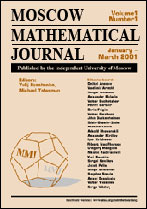|
This article is cited in 2 scientific papers (total in 2 papers)
The Klein quartic as a cyclic group gene
G. Lachaud
Institut de Mathématiques de Luminy
Abstract:
Let $k$ be a field, and let $a$, $b$, $c$ be three elements in $k^X$. The nonsingular projective plane curve $X$ defined over $k$ with equation
$$
ax^3y+by^3z+cz^3x=0
$$
has genus 3 and is reduced to the familiar Klein quartic when $a=b=c=1$. The Jacobian $J_X$ of $X$ is a three-dimensional abelian variety, defined over $k$ as well. The aim of this article is to give some formulas for the number of points of the group $J_X(k)$ of rational points of $J_X$ if $k=\mathbb F_q$ is a finite field.
We assume that the full group of seventh roots of unity is contained in $k$; this amounts to saying that $q\equiv 1$ (mod 7). If q is a prime number and the coefficients $a$, $b$, $c$ are appropriately chosen, we noticed that the number of points of the group $J_X(k)$ is prime in a significant number of occurences. This provides cyclic groups which seem to be accurate for cryptographic applications.
Key words and phrases:
Jacobi sum, Faddeev curve, Klein quartic, curve over a finite field, Jacobian, zeta function.
Received: December 16, 2005
Citation:
G. Lachaud, “The Klein quartic as a cyclic group gene”, Mosc. Math. J., 5:4 (2005), 857–868
Linking options:
https://www.mathnet.ru/eng/mmj225 https://www.mathnet.ru/eng/mmj/v5/i4/p857
|

| Statistics & downloads: |
| Abstract page: | 243 | | References: | 63 |
|




 Contact us:
Contact us: Terms of Use
Terms of Use
 Registration to the website
Registration to the website Logotypes
Logotypes








 Citation in format
Citation in format 
